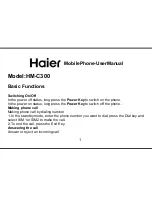
FDA CONSUMER
UPDATE
127
3. What kinds of phones are the subject of
this update?
The term “wireless phone” refers here to hand-
held wireless phones with built-in antennas,
often called “cell,” “mobile,” or “PCS” phones.
These types of wireless phones can expose the
user to measurable radiofrequency energy (RF)
because of the short distance between the phone
and the user’s head. These RF exposures are lim-
ited by Federal Communications Commission
safety guidelines that were developed with the
advice of FDA and other federal health and
safety agencies. When the phone is located at
greater distances from the user, the exposure
to RF is drastically lower because a person’s RF
exposure decreases rapidly with increasing dis-
tance from the source. The so-called “cordless
phones,” which have a base unit connected to
the telephone wiring in a house, typically oper-
ate at far lower power levels, and thus produce
RF exposures far below the FCC safety limits.
4. What are the results of the research done
already?
The research done thus far has produced conflict-
ing results, and many studies have suffered from
flaws in their research methods.
SAFETY AND
WARRANTY
FDA CONSUMER
UPDATE
126
FDA belongs to an interagency working group of
the federal agencies that have responsibility for
different aspects of RF safety to ensure coordi-
nated efforts at the federal level. The following
agencies belong to this working group:
• National Institute for Occupational Safety and
Health
• Environmental Protection Agency
• Federal Communications Commission
• Occupational Safety and Health Administration
• National Telecommunications and Information
Administration
The National Institutes of Health participates in
some inter-agency working group activities, as
well. FDA shares regulatory responsibilities for
wireless phones with the Federal Communications
Commission (FCC). All phones that are sold in the
United States must comply with FCC safety guide-
lines that limit RF exposure. FCC also regulates the
base stations that the wireless phone networks rely
upon. While these base stations operate at higher
power than do the wireless phones themselves,
the RF exposures that people get from these base
stations are typically thousands of times lower
than those they can get from wireless phones. Base
stations are thus not the subject of the safety ques-
tions discussed in this document.
SAFETY AND
WARRANTY
070427_PN-310_EN_M_REV01.indd 126-127
070427_PN-310_EN_M_REV01.indd 126-127
2007.5.7 11:13:15 AM
2007.5.7 11:13:15 AM
Summary of Contents for CDM8905
Page 2: ...User Guide CDM8905...












































